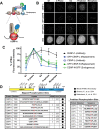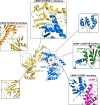Dynamic cell cycle-dependent phosphorylation modulates CENP-L-CENP-N centromere recruitment
- PMID: 35830614
- PMCID: PMC9582625
- DOI: 10.1091/mbc.E22-06-0239
Dynamic cell cycle-dependent phosphorylation modulates CENP-L-CENP-N centromere recruitment
Abstract
The kinetochore is a macromolecular structure that is needed to ensure proper chromosome segregation during each cellular division. The kinetochore is assembled upon a platform of the 16-subunit constitutive centromere-associated network (CCAN), which is present at centromeres throughout the cell cycle. The nature and regulation of CCAN assembly, interactions, and dynamics needed to facilitate changing centromere properties and requirements remain to be fully elucidated. The CENP-LN complex is a CCAN component that displays unique cell cycle-dependent localization behavior, peaking in the S phase. Here, we demonstrate that phosphorylation of CENP-L and CENP-N controls CENP-LN complex formation and localization in a cell cycle-dependent manner. Mimicking constitutive phosphorylation of either CENP-L or CENP-N or simultaneously preventing phosphorylation of both proteins prevents CENP-LN localization and disrupts chromosome segregation. Our work suggests that cycles of phosphorylation and dephosphorylation are critical for CENP-LN complex recruitment and dynamics at kinetochores to enable cell cycle-dependent CCAN reorganization.
Figures







Similar articles
-
Centromere/kinetochore is assembled through CENP-C oligomerization.Mol Cell. 2023 Jul 6;83(13):2188-2205.e13. doi: 10.1016/j.molcel.2023.05.023. Epub 2023 Jun 8. Mol Cell. 2023. PMID: 37295434
-
The CENP-L-N Complex Forms a Critical Node in an Integrated Meshwork of Interactions at the Centromere-Kinetochore Interface.Mol Cell. 2015 Dec 17;60(6):886-98. doi: 10.1016/j.molcel.2015.10.027. Epub 2015 Nov 19. Mol Cell. 2015. PMID: 26698661 Free PMC article.
-
CDK1-mediated CENP-C phosphorylation modulates CENP-A binding and mitotic kinetochore localization.J Cell Biol. 2019 Dec 2;218(12):4042-4062. doi: 10.1083/jcb.201907006. Epub 2019 Nov 1. J Cell Biol. 2019. PMID: 31676716 Free PMC article.
-
Conserved and divergent mechanisms of inner kinetochore assembly onto centromeric chromatin.Curr Opin Struct Biol. 2023 Aug;81:102638. doi: 10.1016/j.sbi.2023.102638. Epub 2023 Jun 20. Curr Opin Struct Biol. 2023. PMID: 37343495 Review.
-
Posttranslational modifications of CENP-A: marks of distinction.Chromosoma. 2018 Sep;127(3):279-290. doi: 10.1007/s00412-018-0665-x. Epub 2018 Mar 22. Chromosoma. 2018. PMID: 29569072 Free PMC article. Review.
Cited by
-
Dynamic phosphorylation of CENP-N by CDK1 guides accurate chromosome segregation in mitosis.J Mol Cell Biol. 2023 Nov 27;15(6):mjad041. doi: 10.1093/jmcb/mjad041. J Mol Cell Biol. 2023. PMID: 37365681 Free PMC article.
-
CENcyclopedia: dynamic landscape of kinetochore architecture throughout the cell cycle.Nat Commun. 2025 Aug 18;16(1):7676. doi: 10.1038/s41467-025-62316-6. Nat Commun. 2025. PMID: 40825761 Free PMC article.
-
CENcyclopedia: Dynamic Landscape of Kinetochore Architecture Throughout the Cell Cycle.bioRxiv [Preprint]. 2024 Dec 5:2024.12.05.627000. doi: 10.1101/2024.12.05.627000. bioRxiv. 2024. Update in: Nat Commun. 2025 Aug 18;16(1):7676. doi: 10.1038/s41467-025-62316-6. PMID: 39677682 Free PMC article. Updated. Preprint.
-
Towards identification of a holocentromere marker in the lepidopteran model Spodoptera frugiperda.Chromosoma. 2025 Mar 11;134(1):2. doi: 10.1007/s00412-025-00828-2. Chromosoma. 2025. PMID: 40067534 Free PMC article.
-
Disrupting CENP-N mediated SEPT9 methylation as a strategy to inhibit aerobic glycolysis and liver metastasis in colorectal cancer.Clin Exp Metastasis. 2024 Dec;41(6):971-988. doi: 10.1007/s10585-024-10316-z. Epub 2024 Oct 19. Clin Exp Metastasis. 2024. PMID: 39424682
References
Publication types
MeSH terms
Substances
Grants and funding
LinkOut - more resources
Full Text Sources

